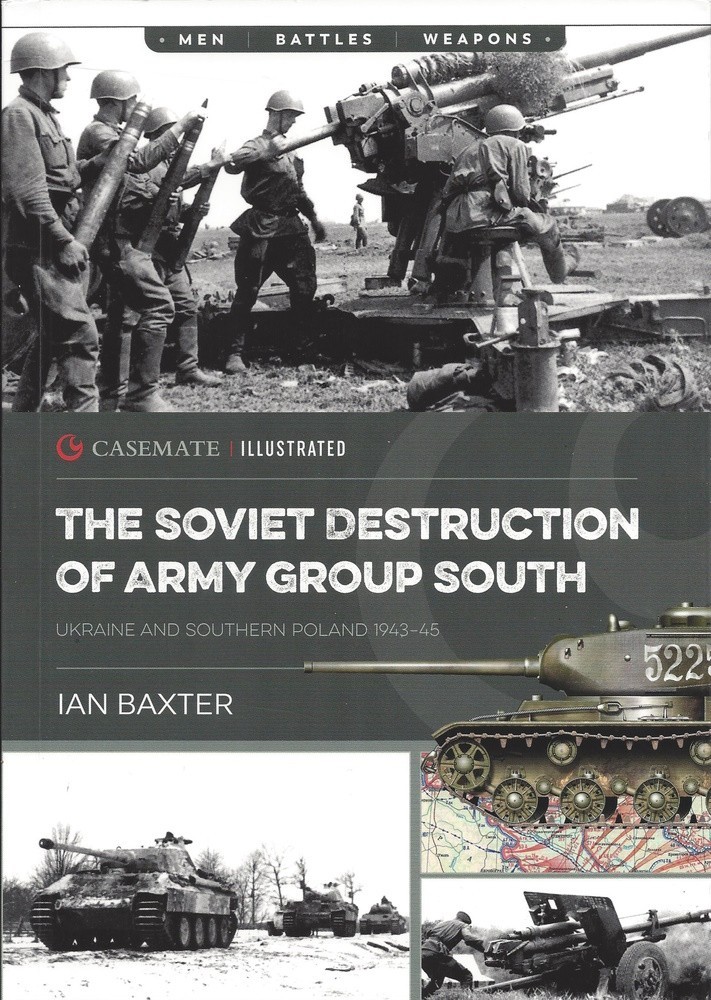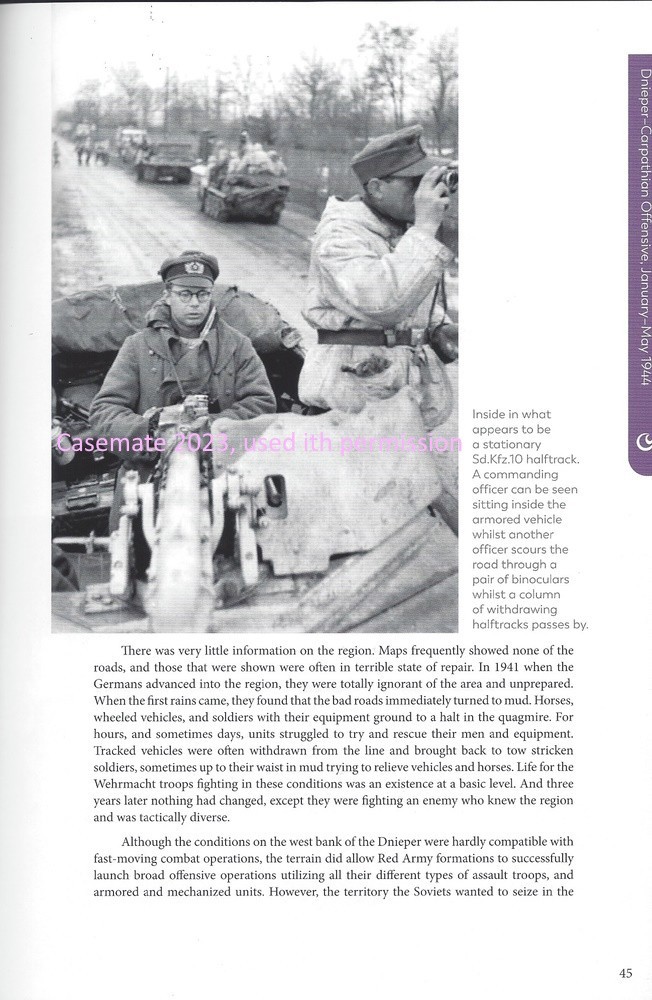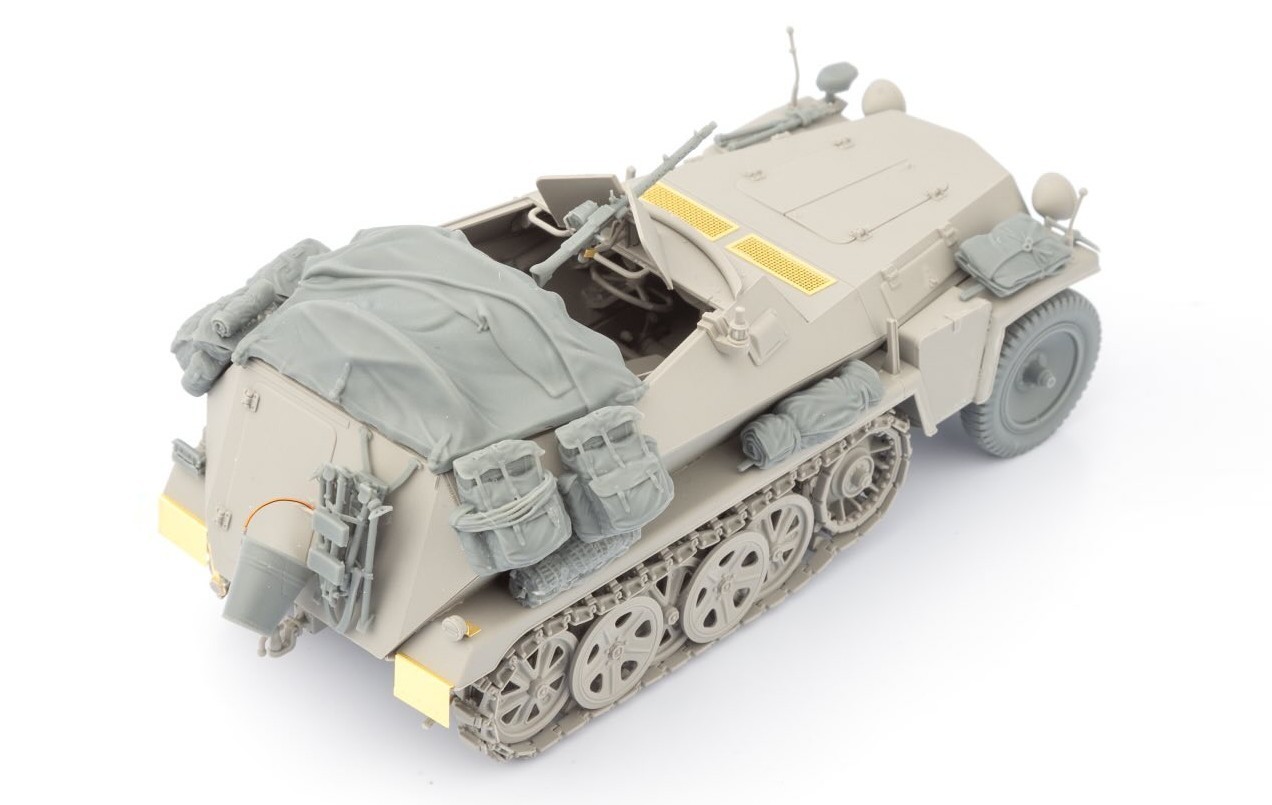
Introduction
The Soviet Destruction of Army Group South, Ukraine and Southern Poland 1943-1945 is a new book from Casemate Publishers in their Casemate Illustrated series. Authored by Ian Baxter, cataloged with ISBN 9781636242620, this 128 glossy page paperback will take up a 7 X 10 inch space on your bookshelf. Key features are special artwork, maps and a wealth of previously unpublished photographs.
I foresee plenty of source material for modeling subject in addition to the pure historical archive presented in this book. It covers the late 1943-1945 campaign against the Wehrmacht across the Ukraine, the Crimea, across the Dnieper and into Eastern Poland and Romania, embroiling over three million men in a large offensive that spanned almost 1,000 miles. Casemate writes;
Drawing on rare and previously unpublished images accompanied by detailed captions and text, the book gives a fascinating analysis of the destruction of Army Group South in southern Russia between 1944 and 1945.

Content
The Soviet Destruction of Army Group South is presented through 128 pages organized into 11 chapters and sections:
Timeline of Events
Introduction: Prelude to Disaster
Soviet Forces
German Forces
Battle of the Dnieper, August-December 1943
The Dnieper–Carpathian offensive, January-May 1944
Battle of the Crimea, April-May 1944
The Lwow–Sanomierz Offensive, July-August 1944
Vistula-Oder Offensive, January-February 1945
Defeat, February-March 1945
Epilogue
Further Reading
In my previous reviews of Casemate Illustrated books I meant to mention a unique feature of the series - each chapter is marked with a colored stripe along the upper corner of each page for easy orientation. Each chapter begins with a concise overview of the subject. I should mention that as well as overviews and background information from the front line, the book also presents details of decisions made in Berlin, including Hitler's contributions to Allied victory. Occasional call-out boxes highlight interesting information and orders of battle for specific periods, illustrations of men and vehicles, and descriptions of entire army groups. Belgian SS volunteers participated in several battles and are included.
Timeline of Events begins in August,1943. It's easy to read and captures significant events and decisions. Starting with Introduction: Prelude to Disaster, we are greeted with an overview of Operation Barbarossa to the battle of Kursk. It covers in good detail the Nazi’s fortunes from the first day of Barbarossa and the replacement of Field Marshall von Rundstedt with General Reichenau, and three battles for Kharkov.
Soviet Forces starts in 1944 and describes the Red Army from that point focusing on the forces in the Ukraine. This chapter provides a basic description of Soviet force structures. Soviet Commanders presents a brief biography of 11 marshals and generals, and the front they commanded. In much the same way, German Forces and German Commanders covers the elements of a typical Heer and Waffen-SS division, and introduces us to nine German commanders and their Army Groups.
Battle of the Dnieper begins after the German defeat at Kursk. It outlines and describes the beatings and shortages they suffered, Hitler's orders for fortifications, Soviet maps of the Soviet attacks, two-and-a-half pages of orders of battle, and profiles of German armored fighting vehicles. The narrative presents an overview of strategy and general descriptions of the fighting, i.e., the German counteroffensive at Krivoi Rog is explained with two paragraphs, although it does mention the importance of German possession of railway locomotives. Descriptions of the battlefield occasionally give the physical description of the front lines and strong points. It also names the principle points for Soviet river crossings.
The Dnieper–Carpathian Offensive begins with explaining that Stalin wanted the Ukraine as much for its natural resources as to simply drive away the Germans; likewise, that Manstein needed it to protect the approaches to Poland and the Balkans, and Manstein and von Kleist ignoring "Fuehrer Orders." The author describes the terrain west of the Dnieper and the German's complete failure to create accurate maps after almost three years of occupation. It describes their primeval battle with mud, in which the Red Army was more prepared to operate. Again, German and Russian force structures are discussed, i.e., three heavy panzer battalions of Tigers, 18 brigades of StuGs. A one-page orders of battle is included.
That formula of format and content continues with the remaining chapters and epilogue, a synergistic text providing history adding context to the gallery of images. As a modeler, almost every page inspires me to crack open a kit and start gluing and painting. This book is a great primer and starting point for those interested in reading in more depth about these Soviet offensives and the German defense. In no way is that a criticism of the book because Casemate Illustrated series are meant to be just that - richly illustrated publications using visual content supported by text.
Speaking of which...

Photographs, Artwork and Graphics
This book contains numerous callouts and set-out pages presenting data, a great gallery of original artwork and useful maps, as well as a photographic treasure chest for modelers. Almost every group of photographs has at least one that starts the modeling juices percolating, or inspires a diorama. Some of the more engaging photos for my tastes are:
- Red Army horse wagons skirting a knocked-out Marder along a narrow road in rolling craggy terrain
- German flak gun atop a dirt pile next to a semi-dug-in permanent wooden structure, while a crewman entertains his kameraden with an accordion
- 10.5 cm howitzers sheltered in a copse with ammunition and clothes piled along the guns
- T-34 racing along flying a Soviet naval flag
- T-34 dug in under a tarp pitched like a tent across the turret and along the gun
- Many scenes of Germans and Russians along the banks of the Dnieper and fording operations.
Further photos present ideas for simple dioramas and vignettes:
- German mortar crew set up on an open bare stubbly field
- 2 cm flak set in the open on a snowy field
- MG 42 nest
- Red Army senior officer with a child soldier in front of a captured flak halftrack
- T-34s halted on a cobblestone road with tank riders sheltering behind the turrets.
Each image is paired with a caption of varying length and detail.
Color illustrations with captions enhance the book in pages titled In Profile, usually two per page, although not every illustration is actually a profile:
- Volkswagen Schwimmwagen: depicted in profile and shown traversing a watercourse.
- SU-122 Self-propelled howitzer crossing a pontoon bridge.
- T-34/85 Model 43: seen head-on with turret trained full left.
- KV-85 Heavy Tank.
- SS Grenadier 5th SS Panzer Division Wiking: in late-style, two-piece, insulated, reversible suit. The caption states he is armed with a StG 44 but an MP 40 is illustrated.
- SS trooper on motorcycle and sidecar tearing away from a burning Red Army tank.
- T-34/85 Model 1943.
- Sd.Kfz. 3b 2 cm flak Maultier.
- Ilyushin Il-2 Shturmovick: in profile and one shown head-on, crashed.
- Borgward B 3000
- 152 mm Howitzer M1937
- Tiger II, 501st Heavy Tank Battalion
- Tiger I
- 76 mm Divisional gun M1942 (ZiS-3)
- 122 mm Howitzer M1938 (M-30)
- 7.5 cm PaK 40
- Marder II Sd.Kfz. 132
- ISU-152
- ISU-122
Maps
Some maps were created for this book and some are reproductions or photographs of original Soviet maps (and even U.S. Army maps).
- Battle of Dnieper and advance to western Ukraine: Red Army creation
- Battle of Dnieper and advance to western Ukraine: U.S. Army creation
- Red Army advance, March-April 1944
- Crimean final battle, April-May 1944
- Operation Bagration
Several are very detailed but may require magnification to scrutinize fully.



Conclusion
A book of less than 200 pages trying to describe the destruction of Nazi Germany's southern armies will not be rich in scalpel-precise detail, but this book is a very good primer and starting point for those interested in reading about the Soviet offensive and German defense in more depth. In no way is that a criticism of the book because Casemate Illustrated series are meant to be just that - richly illustrated publications using visual content supported by text. You will definitely find that between the covers.
As with the previous two Casemate Illustrated books that I've read and written up, I am impressed with this title and intend to acquire more. As a historian, I think it's well worth the price and the space on the bookshelf. As a modeler, almost every page inspires me to crack open a kit and start gluing and painting.
I think you will find it worth creating shelf space for, too.
Please remember to mention to vendors an Casemate that you saw this product here - on Armorama.




























